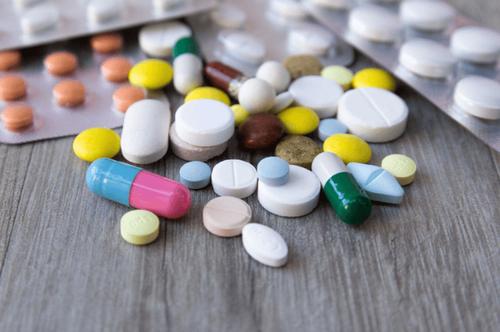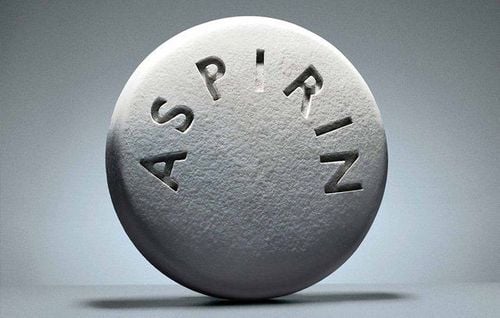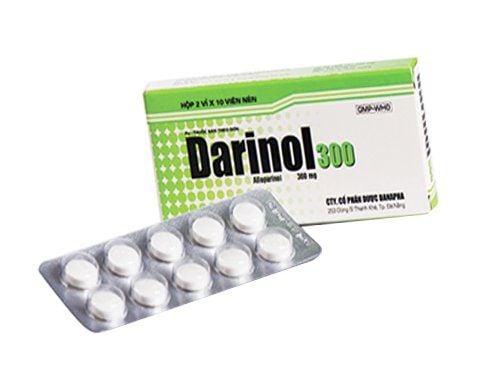This is an automatically translated article.
The main ingredient of Vacodolac is Etodolac, a non-steroidal anti-inflammatory drug (NSAID). The drug has anti-inflammatory effects, effective pain relief and is often indicated in the treatment of osteoarthritis, rheumatoid arthritis, acute gout attacks, pain after surgery, ...
1. What is Vacodolac?
Vacodolac is made in the form of tablets, with the main ingredient being Etodolac 200mg. Etodolac is a nonsteroidal anti-inflammatory drug (NSAID). The drug has effective anti-inflammatory and analgesic effects, so it is often indicated in the treatment of osteoarthritis pain, gout, pain after surgery, tooth extraction, ... The mechanism of action of the drug is inhibition of the COX-2 enzyme. , thereby inhibiting prostaglandin synthesis. Etodolac is a racemic mixture of R-etodolac and S-etodolac. The S form is biologically active, while the R form has a protective effect on the stomach, so the racemic etodolac will reduce the harmful effects on the stomach.
2. Uses of the drug Vacodolac
Indications of the drug Vacodolac include:
Treatment of osteoarthritis, acute gout attacks, rheumatoid arthritis Pain after tooth extraction, surgery or after episiotomy. Menstrual system. Acute musculoskeletal pain has many causes.
3. What are the contraindications of Vacodolac?
Vacodolac is contraindicated in the following cases:
Patients with hypersensitivity to Etodolac or any of the excipients. The patient has recurrent gastric ulcer, gastric bleeding. The patient has had a known hypersensitivity reaction to ibuprofen, aspirin or other NSAIDs. Patients with severe heart failure, severe liver failure or severe renal failure. The patient is pregnant in the last 3 months of pregnancy. History of gastrointestinal bleeding due to previous use of NSAIDs.
4. What is the dose of Vacodolac?
Vacodolac is in the form of film-coated tablets that should be taken orally. Dosage of Vacodolac drug, patients can refer to the following:
Adults and children over 15 years: The recommended dose of Vacodolac is 300-600 mg per day, divided into two times or as a single daily dose. The average dose is from 400 mg/day, taking one 200 mg tablet in the morning and one 200 mg tablet in the evening. The maximum dose may be up to 1000 mg/day in acute attacks. Duration of treatment is usually 1-2 weeks, after which the dose is adjusted according to the patient's response. Children: Vacodolac is not recommended for use in children due to unconfirmed safety. Elderly: No dose adjustment is required at the initial dose. However, it should be used with caution because the elderly are more likely to be severely affected by ADRs. In case of overdose, the patient may have the following symptoms: headache, nausea, vomiting, epigastric pain, gastrointestinal bleeding, drowsiness, dizziness, fainting, coma and occasionally convulsions. In some cases poisoning can cause acute kidney failure and liver damage. When there are signs of an overdose of Vacodolac, the patient should immediately go to the nearest medical facility for timely treatment.
5. Vacodolac side effects
Patients using Vacodolac may experience the following undesirable effects:
Frequency 1 to 10%:
Dermatological: Itching, skin rash Digestive: Abdominal distention, abdominal pain, constipation, diarrhea diarrhea, duodenal ulcer, dyspepsia, peptic ulcer, gastrointestinal bleeding, gastrointestinal perforation, heartburn, nausea, vomiting Genitourinary system: Dysuria, Blood in urine Infection: Infection Nervous system: Chills cold, depression, dizziness, fatigue, headache, irritability, anxiety Neuromusculoskeletal: Joint pain, weakness Ophthalmology: Blurred vision Kidney: Abnormal kidney function Other: Fever, tinnitus Frequency <1%:
Cardiovascular: Heart failure, edema, flushing, hypertension, palpitations, syncope, tachycardia Dermatological: Exfoliative dermatitis, hyperpigmentation, urticaria, vesicular dermatitis Secretion and metabolism: Increased thirst Digestion: Anorexia, stomatitis, esophagitis, glossitis, vomiting, peptic ulcer Genitourinary system: Oliguria, proteinuria Hematology: Anemia, leukocytosis eosinophils, prolonged bleeding time, purpura, rectal bleeding colon, thrombocytopenia Liver: Hepatitis, elevated liver enzymes Hypersensitivity: Angioedema Nervous system: Abnormal dreams, anxiety, confusion, somnolence, insomnia, paresthesia, dizziness
6. Notes when using Vacodolac
During the use of Vacodolac, patients should note the following:
Asthmatic patients: Vacodolac is contraindicated in aspirin-sensitive asthmatics because of severe bronchospasm. and potentially fatal. Hepatic Impairment: Caution should be exercised when administering Vacodolac to patients with hepatic impairment. Your doctor may consider reducing your dose because the drug is extensively metabolized in the liver. Patients with advanced liver disease are at increased risk for gastrointestinal bleeding and renal failure when taking NSAIDs. Renal Impairment: Vacodolac should be avoided in patients with advanced renal disease, unless the benefit outweighs the risk. The patient's renal function should be closely monitored if treatment must be initiated. Effects on the central nervous system: Vacodalac can cause drowsiness, dizziness, blurred vision. Patients should therefore be warned when performing tasks that require mental alertness (eg, operating machinery or driving a vehicle). Drug reactions with eosinophilia and systemic symptoms (DRESS), which can be serious and sometimes fatal, have been reported with NSAIDs. Therefore, it is necessary to monitor for signs and symptoms such as fever, rash, lymphadenopathy, eosinophilia. Gastrointestinal events: Vacodolac increases the risk of serious (possibly fatal) gastrointestinal inflammation, ulceration, bleeding, and perforation. Elderly patients and patients with a history of peptic ulcer and/or gastrointestinal bleeding are at increased risk of serious gastrointestinal events. Vacodolac should be avoided in patients with progressive GI bleeding. Cardiovascular events: NSAIDs may increase the risk of serious cardiovascular thrombotic events, including myocardial infarction and stroke. Events may appear early in the course of treatment and increase with duration of use. Surgical/Dental Procedures: Discontinue at least 24 hours before any surgical or dental procedure. Pregnant women: The drug should be avoided in pregnant women when the pregnancy begins at 20 weeks. If use is required between 20 and 30 weeks of age, the lowest effective dose and shortest possible duration should be used. Amniotic fluid ultrasound monitoring should be considered if treatment lasts longer than 48 hours and discontinuation if oligohydramnios is detected. Because the drug can cause premature closure of the ductus arteriosus, the use of Etodolac in the third trimester of pregnancy is contraindicated. Lactation: In studies to date, NSAIDs may appear in breast milk at very low concentrations. The safety of Vacodolac during lactation has not been established. Therefore, the use of Etodolac should be avoided while breastfeeding.
7. Vacodolac drug interactions
When using Vacodolac at the same time with some other drugs, it may cause interactions, affect the effectiveness or increase side effects of the drug. Therefore, it is best for patients to inform their doctor of all prescription/nonprescription medications they are taking for specific advice. The following are some drug interactions of Vacodolac that need to be clinically noted:
Stomach antacids can reduce the blood concentration of vacodolac drug. Co-administration of Vacodolac with aspirin and other non-steroidal anti-inflammatory drugs will increase the side effects of the drug. Concomitant use with warfarin increases the concentration of free warfarin. Thereby increasing the effect of warfarin, by reducing the binding of warfarin to plasma proteins Blood pressure medicine: Using Vacodolac will reduce the effect of antihypertensive drugs. Diuretics: Vacodolac reduces the diuretic effect and increases the risk of nephrotoxicity. Vacodolac when used with cycloserin, lithium, digoxin, methotrexate will reduce the clearance of these drugs and increase toxicity The above is information about the uses, doses and side effects of Vacodolac. Patients should consult their doctor, pharmacist before using the drug to ensure its effectiveness and avoid unwanted side effects. To ensure the effectiveness of treatment and avoid unwanted side effects, patients need to strictly follow the instructions of the doctor, professional pharmacist.
Follow Vinmec International General Hospital website to get more health, nutrition and beauty information to protect the health of yourself and your loved ones in your family.
Please dial HOTLINE for more information or register for an appointment HERE. Download MyVinmec app to make appointments faster and to manage your bookings easily.













